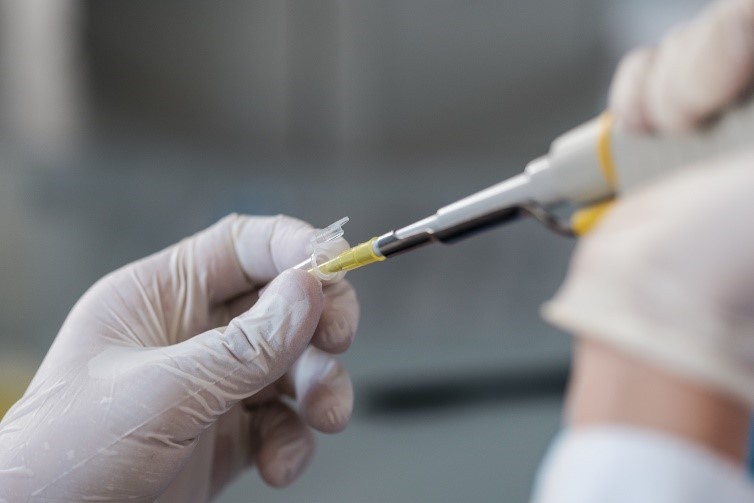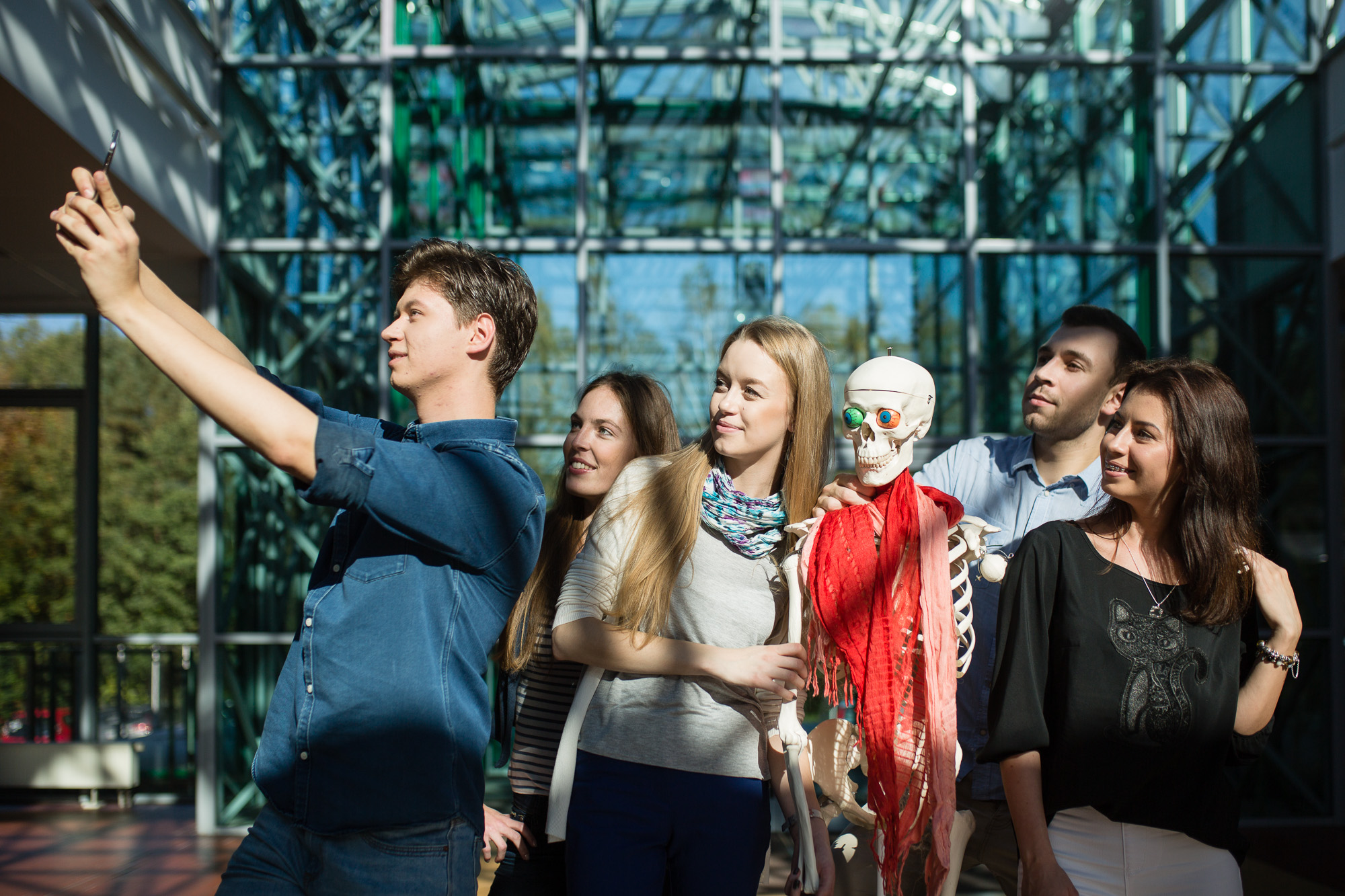PRE-MED Program 
PROGRAM OVERVIEW
PRE-MED is a two-semester (850 academic hours) Program offered by Adam Mickiewicz University, Poznań to candidates who want to improve their knowledge and skills in natural sciences before they start their medical studies. This comprehensive preparatory course taught in English provides a solid foundation in essential areas, ensuring you are well-prepared for the regular degree programs of medical studies.
Apart from courses in biology, chemistry, physics and mathematics, the program provides an opportunity to get basic skills in Polish and communication skills in health care.
The course lasts from mid-October 2025 to the end of June 2026 and is divided into two semesters.
PROGRAM DETAILS (Curricula)
Course dates: October 20th, 2025 – June 30th, 2026
All classes are held in English and cover lectures/seminars, practical classes and laboratories.
AMU PRE-MED includes 850 academic hours*:
- Biology - 250 academic hours
- Chemistry - 250 academic hours
- Physics - 210 academic hours
- Polish - 40 hours
- English - 60 hours
- Communication in Health Care - 40 hours
*academic hour = 45 minutes
* The University reserves the right to withdraw the educational offer unless there are at least 26 candidates submitted, who have passed recruitment successfully
* meals, accommodation and insurance are not provided
APPLICATION CRITERIA
There is no entrance examination. The only requirement is to graduate at least High School and be eligible for university studies in your home country. (No failed results in the transcripts). Even though a certain level of English language is required (B1/B2).
Candidates will be selected by the Admission Committee on the basis of their scores from High School Diploma in biology, physics and chemistry or the relevant subjects and level of English language skills (confirmed by a certificate).
Deadline for the submission of your application:30.06.2025 (notification of acceptance will be given within 2 weeks after the deadline)
Step by step - admission process:
- Register and fill in on-line application form in electronic candidate database (available at: ……………………………………
- Upload the required documents into the electronic database during application process:
- - a copy of High School Diploma or its equivalent in candidate’s native language certified by candidate’s school or by public notary,
- - an English translation of the above original document , translated and certified by candidates school or by a sworn translator (does not apply to documents in English or Polish),
- - a photocopy of the applicant’s passport,
- - certificate confirming English language skills (does not apply to English native speakers),
- - proof of payment of the registration fee in order to receive the pre-acceptance letter
APPLY HERE
COURSE FEES & BANK DETAILS 
Price: 25 300 PLN tuition fee + 2000 PLN non-refundable registration fee
(ca. 6125 USD tuition fee + 485 USD non-refundable registration fee
ca. 5950 EUR tuition fee + 470 EUR non-refundable registration fee)
The registration fee has to be paid before the end of the registration period (proof of payment is required to finalize the registration procedure).
The entire amount of tuition fee (in one instalment) has to be paid after receiving the positive information about the admission.
If you will not be able to start the course because of visa rejection, your tuition fee will be fully refunded.
The tuition fee includes:
- - 850 academic hours of classes,
- - full set of study materials,
- - access to AMU library,
- - participation in Orientation Day (first week of the course),
- - Welcome pack
Above fees should be effected to the account of Adam Mickiewicz University, Poznań in PLN as per following instruction:
University name and address: Uniwersytet im. Adama Mickiewicza w Poznaniu;
ul. Wieniawskiego 1; 61-712 Poznań
title of payment: S0000444 PRE MED; name and surname
account number: 77 1090 1362 0000 0000 3601 7903
IBAN: IBAN: PL77109013620000000036017903
SWIFT: WBKPPLPP
bank name: Santander Bank Polska
Please take under consideration that you might be charged with additional costs while making the payment. The full amount of fee must appear on the University account, so please make sure that all additional banking charges are covered by you.
ADDITIONAL INFORMATION
The classes will be held on-site and there is no possibility to join the classes on-line.
The AMU PRE-MED Program is taught in the Northern Campus Morasko, a modern facility conveniently connected to the city center (15 minutes via a direct tram) and located in a walking distance from the dorm (5-10 minutes depending on the faculty).
Registered students might apply for accommodation in the students' dorms owned and operated by Adam Mickiewicz University, Poznań.
The cost is about:
Single room with bathroom and kitchenette - 980 PLN per month
Double room with bathroom and kitchenette - 730 PLN per person per month
If you want to read more about the dorms, click here.
CONTACT DETAILS
In any case please contact us premed@amu.edu.pl
Ms Karolina Choczaj, MA
International Exchange Advisor
Adam Mickiewicz University, Poznan
Poland
1 Wieniawskiego Street; 61-712 Poznan
Ms Dominika Dąbrowska, MSc
International Exchange Advisor
Adam Mickiewicz University, Poznan
Poland
1 Wieniawskiego Street; 61-712 Poznan
A DOZEN REASONS TO STUDY AT AMU?
- Competitive price

- Supreme academic expertise
- Central location: halfway between Berlin and Warsaw; most European capitals are accessible within 2 hours by plane!
- Poznan is one of the safest cities in Europe
- Multicultural environment
- Student-friendly city: every fourth citizen of Poznan is a student! 30,000 of them study at AMU!
- Vibrant business centre offering career opportunities for students, Poznan region enjoys the lowest unemployment rate in Poland
- Comprehensive academic offer: read on! AMU has been ranked among top-3 Universities in Poland for the last 5 years!
- A large number of professional full-time academic staff
- Advanced research opportunities: AMU got the HR Excellence in Research certificate from the European Commission and is a part of “The Excellence Initiative - Research University Program’’
- Handicap-friendly program: AMU has the largest population of students with disabilities in Poland!
- Easy access to culture

About Adam Mickiewicz University
Founded in 1919
nearly 3000 academic staff
nearly 30 000 students
1040 PhD students,
hundreds of postgraduate diploma students
1 200 international students
In the following turbulent years of Polish history, science and higher education were always vibrant in Poznań. The key role in their development was played by the Poznań Society of Friends of Sciences which preserved the academic legacy forward in partitioned Poland (1795-1918) until the official re-establishment of the University of Poznan, following the end of the First World War, in 1919.
Ever since the University of Poznań has flourished, and only one more time was it forced to go underground and provide its services in the conspiracy during the Second World War under the name of clandestine University of the Western Lands (1940-1944). Despite the Nazi German occupation it managed to educate and produce over 2,000 graduates with the help of some 300 academic teachers, who risked their lives by offering university courses in Polish, which was made illegal during the war.
If you want to learn more about AMU history, click here.
About Poznań

Founded: 9th Century
Town Charter: 1253
Area: 261.3 sq. km
Population: around 540 000 residents, over 100 000 students
Poznan has many sports and leisure centers offering plenty of opportunities to spend your free time. During your time off, choose among Poznan’s many restaurants, cafes, pubs and clubs. A particularly charming atmosphere awaits you in the Old Market Square Area. It’s the center of nightlife in Poznan. Poznan is a city of music, theatre, visual arts and design. If you want to look for more information about the city, click here.
Full sylabus
- Biology - 250 hours of courses
1. The Structure and Function of Large Biological Molecules.
The diversity of polymers. Carbohydrates. Proteins. Nucleic acids. Lipids.
2. Prokaryotic cell structure and function.
Cell surface structures. Motility. Internal organization and DNA (nucleoid, plasmids). Binary fission and conjugation in bacteria.
3. Eukaryotic cell structure and function.
Plasma Membrane. Compartmentalization. Cytoskeleton. Endomembrane system: endoplasmic reticulum, Golgi Apparatus and lysosomes. The Nucleus. Ribosomes. Mitochondria.
4. Cell communication.
Cell junctions. Local and long distant signaling. Chemical messengers. Receptors. The stages of cell signaling.
5. Cell cycle.
Mitosis and meiosis. Cellular organization of genetic material. Phases of cell cycle. The mitotic spindle. Cytokinesis. Cellular organization of genetic material. The stages of mitosis and meiosis. A comparison of Mitosis and Meiosis. Origins of genetic variation among offspring.
6. Cellular respiration and fermentation.
Catabolic pathways and production of ATP. The stages of cellular respiration (glycolysis, oxidation of puryvate, citric acid cycle, oxidative phosphorylation). Anaerobic respiration. Types of fermentation.
7. Viruses.
Structure of viruses. General features of viral replication cycles. Viroids and prions. Viral diseases. Emerging viruses.
8. Bacteria and Archaea.
Cell surface structures. Motility. Internal organization. Reproduction and adaptation. Diverse nutritional and metabolic adaptation – oxygen and nitrogen metabolism, cooperation. The role in the biosphere (chemical recycling, ecological interactions). Beneficial and harmful impacts of Prokaryotes on humans.
9. Protists
Structural and functional diversity in Protists. Role of Protists in ecological communities.
10. Fungi.
Nutrition and Ecology. Body structure. Sexual and asexual reproduction. Fungi as pathogens. Practical uses of fungi.
11. Chromosomal and Molecular Basis of Inheritance.
The chromosomal basis of sex. Inheritance of X- and Y-linked genes. Alternation of chromosome number and structure. Human disorders due to chromosomal alternation. Inheritance of organelle genes. DNA as genetic material. Structural model of DNA. Chromosomes’ structure.
12. Genetic mechanisms.
The flow of genetic information. Replication: base paring to a template strain, synthesis of new DNA strands. Transcription: molecular components of transcription, posttranscriptional modifications (alternation of mRNA ends, RNA splicing). Translation: molecular components of the process. Building of polypeptide. Genetic code. Type of mutations.
Regulation of Gene Expression (promoters, transcription factors).
13. Tissues and body membranes.
Structure and physiology of: connective, muscle, epithelial and nervous tissue; serous, mucous, synovial and cutaneous membranes.
14. Senses.
Hearing and equilibrium. Visual perception. Taste. Smell. Types of sensory receptors.
15. Nervous system.
Organization of nervous system. The central nervous system. The organization of human brain. Peripheral nervous system: motor and autonomic nervous system. Glia. Blood-brain barrier. Nervous system disorders.
16. Neurons, synapses and signaling.
Neurons structure and function. Resting and action potential. Conduction of action potentials. Postsynaptic potential. Neurotransmitters.
17. Hormones and endocrine system.
Intercellular communication. Endocrine tissues and organs. Chemical classes of hormones. Multiple effects of hormones. Simple hormone pathways. Feedback regulation.
18. Immune system. Innate and adaptive immunity.
Antigen. Antibody. The humoral immune response. The cell-mediated immune response. Inflammatory response. Immunological memory. Allergies. Immunization (vaccination).
19. Cardiovascular system.
Organization of human circulatory system. Heart and heart’s rhythmic beat. Blood vessels structure and function. Blood pressure. Blood composition and function.
20. Respiratory system.
Organization of human respiratory system. Negative pressure breathing. Hemoglobin.
21. Digestive system and nutrition.
Essential nutrients. Dietary deficiencies. Organization of human digestive system. Chemical digestion in the human digestive system. Dental adaptation.
22. Human reproduction and development.
Female and male reproductive anatomy. Hormonal control of reproductive system. Gametogenesis. Conception. Embryonic development. Birth.
23. Osmoregulation and excretion.
Excretory organs. Kidney structure. Nephron organization and function. Kidney function, water balance and blood pressure.
24. Evolution.
Evolution of population. Evolution of human being. The Origin and Evolution of Vertebrates. Phylogeny and the Tree of Life.
25. Ecology
Biotic and abiotic factors, habitats, niches, levels of organization, symbiosis, mutualism, parasitism, commensalism, trophic levels, nutrient cycles (water, carbon and nitrogen), food chains, primary producers, types of consumers, energy and biomass pyramids, limiting factors, tolerance, carrying capacity, adaptation, succession, climax community, pioneer species, biomes.
26.Genetics of population.
Genetic drift and effective population size, bottleneck effect, adaptation and phenotypic variance, Hardy-Weinberg equilibrium, maximum likelihood and Bayesian analysis. - Chemistry - 250 hours of courses
1. Atoms
Atomic theory
Elements and atomic number Isotopes and atomic weight
2. The Periodic Table The periodic table and some characteristics of different groups Electronic structure of atoms and electron configurations Electron configurations and the periodic table Electron-dot symbols
3. Ionic Compounds The octet rule ions and ionic bonds Periodic properties, ion formation formulas, naming ionic compounds Some properties of ionic compounds H + and OH - ions: an introduction to acids and bases 4. Molecular Compounds Covalent bonds and the periodic table Multiple covalent bonds and coordinate covalent bonds Characteristics of molecular compounds Molecular formulas and Lewis structures Polar covalent bonds and electronegativity, polar molecules Naming binary molecular compounds
5. Classification and Balancing of Chemical Reactions Classes of chemical reactions
Chemical equations and balancing chemical equations Acids, bases, and neutralization reactions Redox reactions 6.Mole and Mass Relationships The mole and Avogadro’s number Gram–mole conversions
7. Reaction Rates and Chemical Equilibria.
Endothermic and exothermic chemical reactions
Factors that influence chemical reaction rates Chemical equilibrium
Equilibrium constants
8. Nuclear Chemistry
Radioactivity
Radioactive half-life
9. Physical quantities
Metric system of units Metric units of length Metric units of mass Metric units of volume
Significant figures
10. Fundamental Chemical Laws
Law of conservation of mass
Law of definite proportions
Law of multiple proportions
11. Chemical Calculations
Mole concept and chemical formulas
Calculations involving chemical equations
Calculations involving volume and concentration
12. Solutions Mixtures and solutions Units of concentration Dilution Ions in solution: electrolytes
13. Acids and Bases Acids and bases in aqueous solution, some common acids and bases The Brønsted–Lowry definition of acids and bases Acid dissociation constants. Acid and base strength Some common acid–base reactions
Acidity and basicity of salt solutions
14. Buffers
Measuring acidity in aqueous solution: pH Buffer solutions Titration
15. Introduction to Organic Chemistry: Alkanes The nature of organic molecules The structure of organic molecules: alkanes and their isomers Drawing organic structures
The shapes of organic molecules Naming alkanes Properties of alkanes Reactions of alkanes
16. Cycloalkanes Drawing and naming cycloalkanes 17. Alkenes and Alkynes Alkenes and alkynes Naming alkenes and alkynes The structure of alkenes: cis–trans isomerism Properties of alkenes and alkynes Types of organic reactions Reactions of alkenes and alkynes
18. Aromatic Compounds
Alkene polymers Aromatic compounds and the structure of benzene Naming aromatic compounds Reactions of aromatic compounds 19. Alcohols Some common alcohols Naming alcohols Properties of alcohols, acidity of alcohols Reactions of alcohols
20. Phenols
Some common phenols Acidity of phenols
21. Some Compounds with Oxygen, Sulfur, or a Halogen Ethers Thiols and disulfides Halogen-containing compounds 22. Amines Amines Properties of amines Heterocyclic nitrogen compounds Basicity of amines Amine salts
23. Aldehydes The carbonyl group Naming aldehydes Properties of aldehydes Some Common aldehydes Oxidation of aldehydes Reduction of aldehydes
24. Ketones
Naming ketones
Properties of ketones
Some Common ketones
Reduction of ketones 25. Carboxylic Acids and their Derivatives Carboxylic acids and their derivatives: properties and names Some common carboxylic acids Acidity of carboxylic acids Reactions of carboxylic acids: ester and amide formation
Hydrolysis of esters and amides
26. Amino Acids and Proteins Amino acids structures Acid–base properties of amino acids Chemical properties of proteins
27. Enzymes and Vitamins Catalysis by enzymes How enzymes work Vitamins and minerals 28. Carbohydrates
Classification of carbohydrates The D and L families of sugars: drawing sugar molecules Structure of glucose Disaccharides, structure of maltose Some important polysaccharides Properties of carbohydrates
29. Lipids
Structure and classification of lipids Fatty acids and their esters Properties of fats and oils
30. Nucleic Acids and Protein Synthesis DNA, chromosomes, and genes Composition of nucleic acids The structure of nucleic acid chains Base pairing in DNA: the Watson–Crick model - Physics - 210 hours of courses
Module total hours: 210 (lectures 70 h, classes 110 h, laboratories 30 h)
Mechanics:
- motion, velocity, acceleration
- forces, work, Newton’s laws of motion
- energy, momentum, angular momentum, conservation laws
- gravity
- liquids – Archimedes principle, Pascal principle, Bernoulli equation, surface tension
Teaching methods and hours: lecture (20 h), classes (20 h), laboratory (10 h)
Electricity and magnetism:
- electric charge, Coulomb’s law
- electric field, electric potential, capacitors, capacity
- electric current, voltage and current, resistance, Ohm’s law
- magnetic field, Ampere’s law
- electromagnetic induction, Maxwell equations
Teaching methods and hours: lecture (10 h), classes (30 h)
Vibrations and Sound:
- harmonic motion, amplitude, period, frequency
- damped vibrations, forced vibrations, resonance
- waves – perpendicular and longitudinal, wavelength
- reflection and interference of waves
- sound – characteristics, beats, Dopler’s effect, shock wave, ultrasound
Teaching methods and hours: lecture (10 h), classes (20 h), laboratory (10 h)
Light and Optics:
- light and electromagnetic waves
- geometric optics, the law of reflection, the law of refraction (Snells’s law), refractive index
- lens equation, optical instruments
- wave nature of light - Huyghen principle, diffraction and interference of light
- polarization of light, liquid crystal display
Teaching methods and hours: lecture (10 h), classes (20 h), laboratory (10 h)
Heat and atomic structure of matter:
- atomic structure of matter
- temperature and thermal equilibrium
- ideal gas and its transformation
- heat, specific heat, calorimetry
- entropy, laws of thermodynamics
Teaching methods and hours: lecture (20 h), classes (20 h)